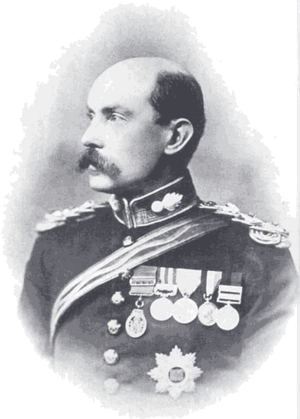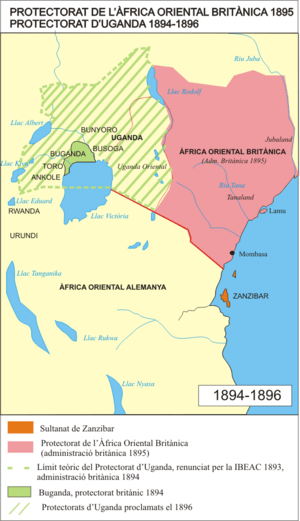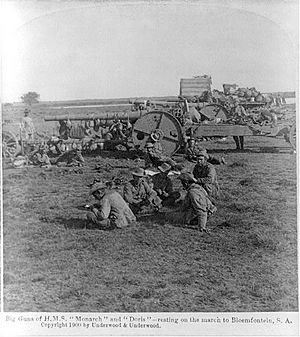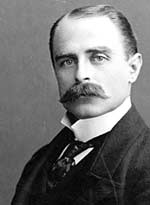James Macdonald (British Army officer) facts for kids
Quick facts for kids
Sir James Macdonald
|
|
|---|---|
 |
|
| Commissioner of Uganda (acting) | |
| In office 30 May 1893 – 4 November 1893 |
|
| Preceded by | Gerald Herbert Portal |
| Succeeded by | Henry Edward Colville |
| Personal details | |
| Born | 8 February 1862 Rajamundry, Madras Presidency, British India |
| Died | 27 June 1927 (aged 65) Bournemouth, England, United Kingdom |
| Alma mater | University of Aberdeen |
| Profession | Soldier, engineer |
Major General Sir James Ronald Leslie Macdonald (8 February 1862 – 27 June 1927) was a British engineer, explorer, and military officer. He was also a skilled mapmaker. Born in Madras Presidency, India, he started his career observing from balloons. He helped survey routes for railways in India and East Africa. Macdonald explored the upper Nile region and led balloon sections in the Second Boer War and Boxer Rebellion. He also commanded the British expedition to Tibet in 1903–1904.
Contents
Early Life and Career Beginnings
James Macdonald was born on 8 February 1862 in Rajahmundry, India. His father was a surgeon, and his younger sister, Nora Griffith, became a famous archaeologist. James went to Aberdeen Grammar School and the University of Aberdeen in Scotland.
After his studies, he joined the Royal Engineers in 1882. This group of soldiers specializes in engineering tasks. In 1885, as a lieutenant, Macdonald worked in Calcutta, India. He was a pioneer in using balloons for photography. He also worked on railway projects in India and took part in a military campaign in 1888.
In 1891, Macdonald was about to go on leave to England. Instead, he was asked to be the chief engineer for a new railway survey. This railway would run from Mombasa to Lake Victoria in East Africa. He accepted the job and later became a member of the Royal Geographical Society.
Building the Uganda Railway
The Imperial British East Africa Company (IBEA Co) hired Macdonald for a big project. He was to plan a railway route from Mombasa on the Indian Ocean to Lake Victoria. This path would mostly follow an existing trade route.
The survey began in December 1891 and lasted over a year. Macdonald faced many challenges during this time. His team dealt with sickness, attacks from ants, bees, lions, and elephants. They also had to overcome tough landscapes and unfriendly local groups. These difficulties made the work very hard for his carriers and other helpers.
Macdonald's survey showed that the old trade route was the best path for the railway. It also found the easiest way to cross the Mau Escarpment and reach Lake Victoria. Macdonald and his second-in-command, John Wallace Pringle, suggested building a specific type of railway. They believed the railway was important for connecting the new colony. The IBEA Co did not have enough money to build the railway. So, the British government took over in 1895. Construction of the railway started that same year.
During his survey, Macdonald was impressed by the intelligent Baganda people living north of the lake. In May 1893, he became the Acting British Commissioner of the Uganda Protectorate. He was told to avoid interfering with the local affairs of Buganda. He moved all the Sudanese troops from the western part of the country. In 1894, he was a chief officer in an expedition to the nearby kingdom of Bunyoro. Later, he returned to India for another assignment.
The Nile Expedition
In 1897, Macdonald was in London when he was chosen to lead another expedition to Uganda. The main goal was to check the northern borders. Britain was worried that France or Italy might claim parts of the land. At the same time, General Herbert Kitchener was moving up the Nile towards Khartoum. A French group, led by Jean-Baptiste Marchand, was also crossing Africa towards Fashoda on the Nile. Macdonald's orders were to reach Fashoda first.
The expedition officers arrived in Mombasa in July 1897. After setting up a base camp, the force split into three groups. One group would explore north. Macdonald's group would go northwest to the Nile and then downstream to Fashoda. A third group would provide supplies.
However, these plans changed when the Nubian soldiers, who were supposed to protect them, deserted. These soldiers had a history of problems with the British. Macdonald spent seven months trying to stop their rebellion. In May 1898, troops from India arrived to help. After the rebellion was stopped, Macdonald suggested keeping Indian soldiers in the country. He thought Sudanese troops could be useful, but only if there were independent Indian soldiers as well.
By May 1898, Macdonald realized he didn't have enough people or supplies to reach Fashoda. Instead, his group aimed for Lado, further south on the Nile. The other group continued exploring around Lake Rudolf. On the way to Lado, Macdonald's group passed through Lotuko country. The Lotuko chief welcomed them. Macdonald noticed similarities between the Lotuko and the Maasai people. Because of this, he later suggested adding Lotuko lands to Uganda.
Both of Macdonald's groups returned to Mombasa by December 1898. They had completed their new tasks. This expedition was one of the last events in the "Scramble for Africa." This was a time when European countries took control of almost the entire African continent. Macdonald was honored for his service in 1900.
Military Service and Innovations
Macdonald had joined the Royal Geographical Society in 1891. In June 1899, he shared stories of his African expedition with the society. His next assignment was in South Africa. Here, he helped introduce new balloon observer sections for the British army. These balloon units greatly helped the British in the Second Boer War. This war involved the British fighting Dutch settlers who wanted to remain independent.
The Second Boer War brought new inventions to warfare. These included the field telephone, searchlights, and barbed wire. Artillery barrages, where many cannons fired together, supported soldiers advancing against enemies in trenches. This tactic was later used a lot in the First World War.
In August 1900, Macdonald went to China. He commanded the fourth Balloon section with British troops fighting in the Boxer Rebellion. He then became the Director of Railways for the British forces in China. The fighting in China happened because European powers wanted more trade and control there. This led to a popular uprising and a siege of Europeans in Beijing. European countries worked together to stop the uprising. After China, Macdonald was sent to Mauritius as a general officer later in 1900.
The Tibet Expedition
In 1903, Britain was concerned about Russia's plans near India. To show their strength, the British decided to send a diplomatic mission to Tibet. Colonel Francis Younghusband led this mission. At first, it was meant to be peaceful. But when the Tibetans refused to accept the mission, it turned into an armed invasion.
In October 1903, Macdonald was temporarily promoted to Brigadier-General. He took command of about 2,500 British and Indian troops. His orders were to avoid attacking first and act only in defense. The mission was to advance into Tibet to Gyantse and occupy the Chumbi valley. About 10,000 local workers joined the expedition to help.
The British army left Sikkim on 11 December 1903. They reached Phari in the Chumbi Valley by 22 December. They stayed in Tuna until late March 1904, hoping to talk with the Tibetans. On 31 March, the force moved forward. They soon met about 3,000 Tibetans defending the Guru Pass. A fight broke out when Macdonald insisted the Tibetans give up their weapons. The British opened fire, and the Tibetans had to retreat. Many Tibetans were killed or wounded. The British troops had better training and much stronger weapons, including machine guns. The fight was very one-sided.
The advance continued, reaching Gyantse on 12 April 1904. Macdonald then took half the force back to check supplies and communications. Some people called him "Retiring Mac" because of this. There might have been some disagreements between Macdonald, the military leader, and Younghusband, the political leader. One officer thought Macdonald was too cautious, perhaps due to illness. Younghusband even threatened to quit twice because of Macdonald's careful approach. However, caution was likely needed due to the very difficult mountains and weather. Supplying the troops was a huge challenge.
While Macdonald was away, Younghusband ordered more aggressive actions. He had some small victories, but the situation remained confusing. Younghusband was then placed under Macdonald's command for exceeding his authority. The reinforced British force advanced again. They reached the strong fortress of Gyantse Dzong by 24 June 1904. On 6 July, they broke through the fortress walls and captured it. Macdonald had completed his mission of clearing the path. He then handed command to Younghusband for the final advance to Lhasa. Macdonald received a special honor for his work in Tibet.
Later Years
Macdonald was the general officer commanding in Mauritius from 1900 until he retired from active service in 1912. In 1908, the University of Aberdeen gave him an honorary degree. Sir James Macdonald passed away on 27 June 1927, in Bournemouth, England, at the age of 65.
Images for kids






